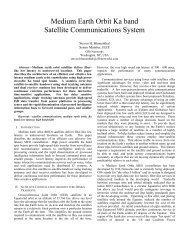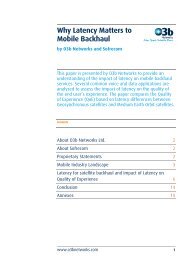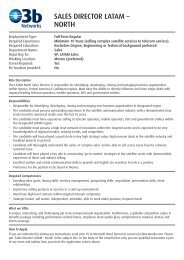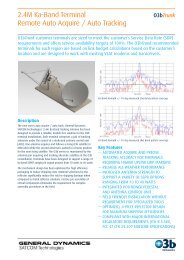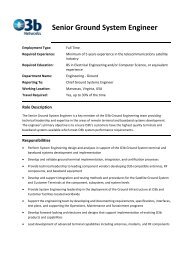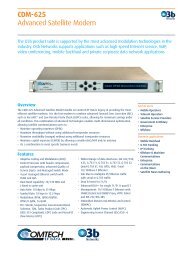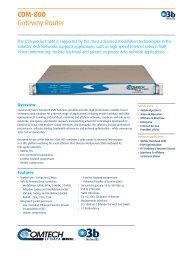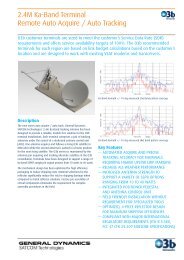Why Latency Matters to Mobile Backhaul - O3b Networks
Why Latency Matters to Mobile Backhaul - O3b Networks
Why Latency Matters to Mobile Backhaul - O3b Networks
Create successful ePaper yourself
Turn your PDF publications into a flip-book with our unique Google optimized e-Paper software.
<strong>Why</strong> <strong>Latency</strong> <strong>Matters</strong> <strong>to</strong> <strong>Mobile</strong> <strong>Backhaul</strong><br />
Interactive user services<br />
The impact of latency on interactive services is more subjective. As the<br />
delay increases, the applications continue <strong>to</strong> function. However, the sense<br />
of immediacy and the usability degrades. At some point, the user becomes<br />
less <strong>to</strong>lerant of waiting for the response, eventually giving up and moving<br />
on <strong>to</strong> something more satisfying. A great deal of research has been done<br />
by companies whose revenues are impacted when users abandon their<br />
transactions.<br />
The importance of latency on web commerce was first showcased by Zona<br />
Research in 1999 with the popular “8-second rule”. Zona found that more<br />
than $4 billion e-commerce sales were lost due <strong>to</strong> poor site performance,<br />
which ultimately led <strong>to</strong> transaction abandonment. In a follow up study in<br />
2006, Jupiter Research concluded that the threshold had been reduced <strong>to</strong> 4<br />
seconds, as more users experience the performance of high-speed<br />
broadband.<br />
Google discovered that the number of web searches and ad revenue<br />
declined as they increased the number of user search results from 10 <strong>to</strong> 30.<br />
Further research found the result was due <strong>to</strong> the additional time required <strong>to</strong><br />
compute and present more results <strong>to</strong> the user. Increasing the results from<br />
10 <strong>to</strong> 30 required an additional 500ms <strong>to</strong> compute and resulted in a 25%<br />
drop in the number of searches done by users. Following this initial study,<br />
Google performed additional tests focused exclusively on the latency. They<br />
injected artificial delay in<strong>to</strong> the display of the search results. An increase in<br />
display time of 400ms actually decreased the number of searches per users<br />
by 0.44% <strong>to</strong> 0.76%. While these drops in usage appear small, they had a<br />
direct and meaningful impact on ad revenue.<br />
Similarly with Amazon: “We tried delaying the page in increments of<br />
100 milliseconds and found that even very small delays would result in<br />
substantial and costly drops in revenue,” said researcher Greg Linden.<br />
Linden provides a precise figure: -1% sales for 100ms or more latency.<br />
(Greg Linden in “Make Data Useful”, Data Mining course Stanford in 2006).<br />
Steve Souders from O’Reilly adds more examples in a blog posting<br />
http://radar.oreilly.com/2009/07/velocity-making-your-site-fast.html.<br />
In “Performance Related Changes and their User Impact,” Eric Schurman<br />
(Bing) explains that Bing researchers have conducted tests adding a static<br />
delay of 50 ms <strong>to</strong> 2 seconds <strong>to</strong> their servers. A negative impact on the Bing<br />
performance indica<strong>to</strong>rs resulted as soon as the delay increased by more<br />
than 50ms. The degradation noticed was linear.<br />
www.o3bnetworks.com 9



